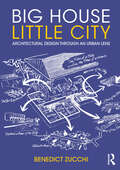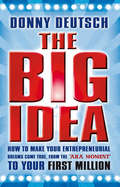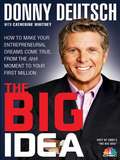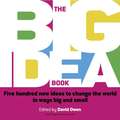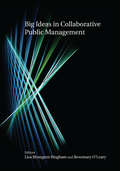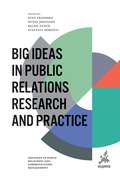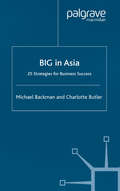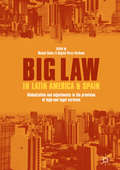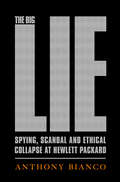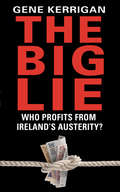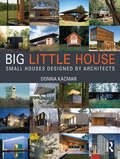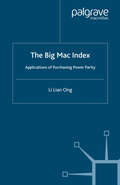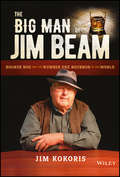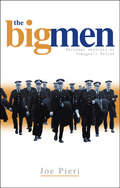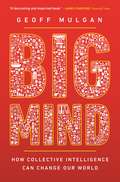- Table View
- List View
Big House Little City: Architectural Design Through an Urban Lens
by Benedict ZucchiCombining architectural and urban thinking in an unusual and engaging way, this book presents an integrated approach to architectural theory and design. Leon Battista Alberti’s assertion in his famous Renaissance treatise that ‘the city is like a big house, and the house is in turn like a little city’ forms the springboard for a series of reflections on architecture’s relationship with urbanism and how their once intimate symbiosis, unravelled by International Style Modernism, can be recovered. Explicit references to Alberti’s house-city phrase have been made by figures as diverse as the architects Louis Kahn, Aldo Van Eyck, Denys Lasdun and Niels Torp and novelist Italo Calvino. But, as the book shows, thinking of buildings as little cities provides a new lens through which to reappraise the contributions of many other architects, including Le Corbusier, Frank Lloyd Wright, Alvar Aalto, Eliel Saarinen, Bernard Rudofsky, Hans Scharoun, Leon Krier, Fumihiko Maki, Charles Correa and Team 10. In doing so, the author identifies common themes that form an unexpected bridgehead between the urban and architectural approaches of Antiquity, the Middle Ages, Renaissance and 20th century. The book explores buildings from across the globe, including lesser-known projects, such as Wright’s unbuilt house in Italy or Saarinen’s master plan for Cranbrook Academy, as well as more recent projects by Niels Torp, Behnisch Architekten, Sou Fujimoto, Peter Barber and WOHA. It concludes with practical case studies of residential, health, education and workplace projects from different countries, fulsomely illustrated with many drawings and photographs. These show how architectural design viewed through an urban lens provides a conceptual framework for breaking down the scale of large buildings and integrating them with their context. And crucially, these also show a very accessible way of explaining evolving designs to the intended users and eliciting their participation in the design process. The book offers a compelling approach to the design of projects at all scales, within an ecological perspective: the sense that big and small, cities and buildings must be approached holistically if we are to reverse the degradation and depletion of our habitat, both natural and man-made.
Big House Little City: Architectural Design Through an Urban Lens
by Benedict ZucchiCombining architectural and urban thinking in an unusual and engaging way, this book presents an integrated approach to architectural theory and design. Leon Battista Alberti’s assertion in his famous Renaissance treatise that ‘the city is like a big house, and the house is in turn like a little city’ forms the springboard for a series of reflections on architecture’s relationship with urbanism and how their once intimate symbiosis, unravelled by International Style Modernism, can be recovered. Explicit references to Alberti’s house-city phrase have been made by figures as diverse as the architects Louis Kahn, Aldo Van Eyck, Denys Lasdun and Niels Torp and novelist Italo Calvino. But, as the book shows, thinking of buildings as little cities provides a new lens through which to reappraise the contributions of many other architects, including Le Corbusier, Frank Lloyd Wright, Alvar Aalto, Eliel Saarinen, Bernard Rudofsky, Hans Scharoun, Leon Krier, Fumihiko Maki, Charles Correa and Team 10. In doing so, the author identifies common themes that form an unexpected bridgehead between the urban and architectural approaches of Antiquity, the Middle Ages, Renaissance and 20th century. The book explores buildings from across the globe, including lesser-known projects, such as Wright’s unbuilt house in Italy or Saarinen’s master plan for Cranbrook Academy, as well as more recent projects by Niels Torp, Behnisch Architekten, Sou Fujimoto, Peter Barber and WOHA. It concludes with practical case studies of residential, health, education and workplace projects from different countries, fulsomely illustrated with many drawings and photographs. These show how architectural design viewed through an urban lens provides a conceptual framework for breaking down the scale of large buildings and integrating them with their context. And crucially, these also show a very accessible way of explaining evolving designs to the intended users and eliciting their participation in the design process. The book offers a compelling approach to the design of projects at all scales, within an ecological perspective: the sense that big and small, cities and buildings must be approached holistically if we are to reverse the degradation and depletion of our habitat, both natural and man-made.
The Big Idea: How To Make Your Entrepreneurial Dreams Come True, From The Aha Moment To Your First Million
by Donny DeutschBased on the award-winning formula of his hugely popular nightly show on CNBC, Donny Deutsch's The Big Idea is a step-by-step guide for anyone who has ever dreamt of following through on creating their own business. From the 'Aha! Moment' to taking that all-important first leap, Deutsch cheers aspiring entrepreneurs along every step of the way. Starting with how to look for opportunities, through to keeping what you've created going and growing, each stage of the process is illustrated by an invaluable lesson learned by a leading entrepreneur. With the author's irrepressible energy, enthusiasm and expertise providing the engine that drives this incredibly upbeat book, The Big Idea will provide the tools to tackle issues head on, and is the ideal how-to for entrepreneurs - from inventors to artists, marketers to producers, teenagers to retirees.
The Big Idea: How to Make Your Entrepreneurial Dreams Come True, from the Aha Moment to Your First Million
by Donny DeutschIt's the moment when you say, "There's gotta be a better way." It's the moment when you ask, "How can I solve this problem?" Donny Deutsch's hit CNBC show The Big Idea has put the spotlight on that ordinary moment and the people who have the courage and stamina to make their dreams come true. Some people think a big idea is like a lightning bolt striking out of the blue that slams you in the head. But it's hardly ever like that. The big idea isn't an act of God. It's an act of daily life. Simply put, the idea that will make millions starts with an observation. A carpenter gets tired of almost losing a finger every time he slices a bagel. Bam! The Bagel Guillotine. A mother is frustrated that her pantry is full of stale food because the packages don't close. Bam! Quick Seals. Howard Schultz notices on a trip to Italy that there are coffee bars on almost every corner. Bam! Starbucks. None of them had a barrel of cash. None of them had a ton of experience. They had a big idea and the will to follow through. In The Big Idea, Deutsch draws not only on his own tremendous focus and expertise, but on that of dozens of the successful entrepreneurs whom he has interviewed, to help you create your own enterprise. From the "Gut Check Moment" to "Mom Power," The Big Idea takes aspiring entrepreneurs along every step of the way. The Big Idea is your road map to the American dream.
The Big Idea Book: Five hundred new ideas to change the world in ways big and small
by David OwenIdeas are like buses, you wait forever and then 500 come along at once. The Big Idea Book is 500 novel, ingenious and downright crazy ideas designed to inspire, amuse and divert. Developed by the team behind the innovative website, Idea-a-Day at www.idea-a-day.com, it covers everything from business to travel, politics to money and everything in between. Idea-a-Day has a vast network of followers and contributors - some famous, some infamous, some revered, some reviled – who post ideas to be read, enjoyed, used or abused. Seth Godin, Malcolm Maclaren and Wayne Hemmingway are just a few of its fans. In The Big Idea Book all this creative energy is mixed together with unpublished ideas, quotes, cartoons, illustrations and thought-pieces to give creatives and cool office types a visual and intellectual treat guaranteed to kickstart the imagination and creative flair!
Big Ideas in Collaborative Public Management
by Lisa Blomgren Bingham Rosemary O'LearyThe world of public management is changing dramatically, fueled by technological innovations such as the Internet, globalism that permits us to outsource functions anywhere in the world, new ideas from network theory, and more. Public managers no longer are unitary leaders of unitary organizations - instead, they often find themselves convening, negotiating, mediating, and collaborating across borders."Big Ideas in Collaborative Public Management" brings together a rich variety of big picture perspectives on collaborative public management. The chapters are all original and written by distinguished experts. Designed for practical application, they range from examinations of under what conditions collaborative public management occurs to what it means to be a collaborative leader.The contributors address tough issues such as legitimacy building in networks, and discuss ways to engage citizens in collaboration. They examine the design of collaborative networks and the outcomes of collaboration. Detailed introductory and concluding chapters by the editors summarize and critique the chapters, and frame them as a reflection of the state of collaborative public management today.
Big Ideas in Collaborative Public Management
by Lisa Blomgren Bingham Rosemary O'LearyThe world of public management is changing dramatically, fueled by technological innovations such as the Internet, globalism that permits us to outsource functions anywhere in the world, new ideas from network theory, and more. Public managers no longer are unitary leaders of unitary organizations - instead, they often find themselves convening, negotiating, mediating, and collaborating across borders."Big Ideas in Collaborative Public Management" brings together a rich variety of big picture perspectives on collaborative public management. The chapters are all original and written by distinguished experts. Designed for practical application, they range from examinations of under what conditions collaborative public management occurs to what it means to be a collaborative leader.The contributors address tough issues such as legitimacy building in networks, and discuss ways to engage citizens in collaboration. They examine the design of collaborative networks and the outcomes of collaboration. Detailed introductory and concluding chapters by the editors summarize and critique the chapters, and frame them as a reflection of the state of collaborative public management today.
Big Ideas in Public Relations Research and Practice (Advances in Public Relations and Communication Management #4)
by Finn Frandsen Winni Johansen Ralph Tench Stefania RomentiBig Ideas can do many things. They are transformative and change the way we work and communicate in organizations and societies. As Big Ideas are dynamic, they can cross borders between disciplines to create new relationships between people, organizations and countries. In applying big ideas to public relations, this volume challenges how scholars and practitioners perceive and understand public relations within an organizational setting. In thinking about the 'bigger picture', the collection expands public relations research to include more theory-building, more cross-disciplinary research, and more innovation in practice. The 12 unique contributions from scholars based in Germany, Denmark, The Netherlands, France, Romania, the UK, Finland, Portugal and the USA explore the challenges surrounding communication, management and big ideas. Some of the topics discussed include: corporate identity, millennial engagement, strategic communication in the internationalization of firms, public relations in the start-up community and, social capital.
Big Ideas in Public Relations Research and Practice: Strategic Opportunities, Innovation And Critical Challenges (Advances in Public Relations and Communication Management #4)
by Finn Frandsen Winni Johansen Ralph Tench Stefania RomentiBig Ideas can do many things. They are transformative and change the way we work and communicate in organizations and societies. As Big Ideas are dynamic, they can cross borders between disciplines to create new relationships between people, organizations and countries. In applying big ideas to public relations, this volume challenges how scholars and practitioners perceive and understand public relations within an organizational setting. In thinking about the 'bigger picture', the collection expands public relations research to include more theory-building, more cross-disciplinary research, and more innovation in practice. The 12 unique contributions from scholars based in Germany, Denmark, The Netherlands, France, Romania, the UK, Finland, Portugal and the USA explore the challenges surrounding communication, management and big ideas. Some of the topics discussed include: corporate identity, millennial engagement, strategic communication in the internationalization of firms, public relations in the start-up community and, social capital.
Big in Asia: 25 Strategies for Business Success
by M. Backman C. ButlerCompanies operating in post-crisis Asia find themselves confronted by obstacles that hinder development and progress. Written by two leading analysts, this book identifies the transformation of the competitive landscape in Asia. By focusing on the main difficulties faced by companies it provides a series of strategies for business success and show how to avoid failure in Asia. This is an essential guide for companies who wish to make it big in Asia.
Big Law in Latin America and Spain: Globalization and Adjustments in the Provision of High-End Legal Services
by Manuel Gómez Rogelio Pérez-PerdomoThis book, part of the Stanford Law School research project on the future of the legal profession, thoroughly examines the future of “big law,” defined as the large and mid-size multiservice highly specialized law firms that provide sophisticated, complex and generally costly legal work to multinationals, large and mid-size domestic corporations, and other business clients. By systematically gathering, assessing, and analyzing the best available quantitative and qualitative data on the first tier of the corporate legal services market of Latin America and Spain, and interviewing a broadly representative sample of corporate legal officers, law firm partners, and other stakeholders in each of the countries covered, this book provides a nuanced perspective on changes in “big law” during the last two decades until the present. It also explores the factors that are driving these changes, and the implications for the future of legal profession, legal education and its relationship with the corporate sector and society in general.
Big Law in Latin America and Spain: Globalization and Adjustments in the Provision of High-End Legal Services
by Manuel Gómez Rogelio Pérez-PerdomoThis book, part of the Stanford Law School research project on the future of the legal profession, thoroughly examines the future of “big law,” defined as the large and mid-size multiservice highly specialized law firms that provide sophisticated, complex and generally costly legal work to multinationals, large and mid-size domestic corporations, and other business clients. By systematically gathering, assessing, and analyzing the best available quantitative and qualitative data on the first tier of the corporate legal services market of Latin America and Spain, and interviewing a broadly representative sample of corporate legal officers, law firm partners, and other stakeholders in each of the countries covered, this book provides a nuanced perspective on changes in “big law” during the last two decades until the present. It also explores the factors that are driving these changes, and the implications for the future of legal profession, legal education and its relationship with the corporate sector and society in general.
The Big Lie: Spying, Scandal, and Ethical Collapse at Hewlett Packard
by Anthony BiancoHewlett Packard is an American icon, the largest information technology company in the world. The bedrock of Silicon Valley, it employs more than 300,000 people, its market capitalization is in excess of 100 billion and its products are in almost every home in the country where there is a printer or computer. In 2003 the company began a transition from the family management style of its founders. It made a bold statement by hiring as its new CEO the most visible female business executive in America: Carly Fiorina. Less than two years later, the board fired her, amid accusations of imperiousness that had begun damagingly to leak into the business media. The board at that time included one of Silicon Valley&’s most flamboyant venture capitalists and owner of the largest and most expensive yacht in the world, and a former CIA asset who believed he personally channeled the values of the company&’s founders. Each had a long and complicated history with HP, and each believed he should determine the company&’s future. They ran up against a corporate governance expert whom they could not roll, and a new CEO whose loyalties on the board were entirely opaque. In this way, the stage was set for a rancorous feud that split the board into implacably distrusting factions. In the middle of the damaging schism, HP introduced the Big Lie. The lie was pinned on the chairman, who was receiving treatment for stage 4 ovarian cancer. And it sizzled through a largely unquestioning media. Anthony Bianco gets to heart of the ethical morass at HP that ended up damning the entire board that created it. Almost every American has an interest in how the country&’s greatest corporations are run, and the character of the people entrusted with them. The story of Hewlett-Packard reflects power struggles that shape corporate America and is an alarming morality tale for our times.
The Big Lie: Spying, Scandal, and Ethical Collapse at Hewlett Packard
by Anthony BiancoHewlett Packard is an American icon, the largest information technology company in the world. The bedrock of Silicon Valley, it employs more than 300,000 people, its market capitalization is in excess of 100 billion and its products are in almost every home in the country where there is a printer or computer. In 2003 the company began a transition from the family management style of its founders. It made a bold statement by hiring as its new CEO the most visible female business executive in America: Carly Fiorina. Less than two years later, the board fired her, amid accusations of imperiousness that had begun damagingly to leak into the business media. The board at that time included one of Silicon Valley's most flamboyant venture capitalists and owner of the largest and most expensive yacht in the world, and a former CIA asset who believed he personally channeled the values of the company's founders. Each had a long and complicated history with HP, and each believed he should determine the company's future. They ran up against a corporate governance expert whom they could not roll, and a new CEO whose loyalties on the board were entirely opaque. In this way, the stage was set for a rancorous feud that split the board into implacably distrusting factions. In the middle of the damaging schism, HP introduced the Big Lie. The lie was pinned on the chairman, who was receiving treatment for stage 4 ovarian cancer. And it sizzled through a largely unquestioning media. Anthony Bianco gets to heart of the ethical morass at HP that ended up damning the entire board that created it. Almost every American has an interest in how the country's greatest corporations are run, and the character of the people entrusted with them. The story of Hewlett-Packard reflects power struggles that shape corporate America and is an alarming morality tale for our times.
The Big Lie - Who Profits From Ireland’s Austerity?: Who Profits From Ireland's Austerity?
by Gene KerriganIreland’s economic collapse hit with bewildering speed and cut deep into many lives. At a time when we most needed leadership, our politicians let us down, telling us we were all to blame for the recession and that we just needed to suffer a little pain to make everything right again. It was a Big Lie.This book offers an alternative view to the official cover story of austerity. It’s about the great majority of us who weren’t gambling with our future. It’s about what’s being done to us, who is doing it and why. It’s also about who benefits from this and who gets it in the neck. And what we might do about that.Gene Kerrigan delves deep into the muddy waters of the boom and crash, the chaos in the banks, the intervention by the troika and the erosion of democracy. He looks at how the Dáil and the media became full of mindless free market cheerleaders, how the country became laden down with unregulated bankers, and how the government acquiesced in imposing a destructive programme of austerity on the Irish people.Meanwhile, the elites in our society wrap the green flag around themselves, calling for sacrifice and patriotism, while they hold on fiercely to every perk and privilege. It’s time to tell the truth.
BIG little house: Small Houses Designed by Architects
by Donna KacmarWhat are the challenges architects face when designing dwelling spaces of a limited size? And what can these projects tell us about architecture – and architectural principles – in general? In BIG little house, award-winning architect Donna Kacmar introduces twenty real-life examples of small houses. Each project is under 1,000 square feet (100 square meters) in size and, brought together, the designs reveal an attitude towards materiality, light, enclosure and accommodation which is unique to minimal dwellings. While part of a trend to address growing concerns about minimising consumption and lack of affordable housing, the book demonstrates that small dwellings are not always simply the result of budget constraints but constitute a deliberate design strategy in their own right. Highly illustrated and in full-colour throughout, each example is based on interviews with the original architect and accompanied by detailed floor plans. This ground-breaking, beautifully designed text offers practical guidance to any professional architect or homeowner interested in small scale projects.
BIG little house: Small Houses Designed by Architects
by Donna KacmarWhat are the challenges architects face when designing dwelling spaces of a limited size? And what can these projects tell us about architecture – and architectural principles – in general? In BIG little house, award-winning architect Donna Kacmar introduces twenty real-life examples of small houses. Each project is under 1,000 square feet (100 square meters) in size and, brought together, the designs reveal an attitude towards materiality, light, enclosure and accommodation which is unique to minimal dwellings. While part of a trend to address growing concerns about minimising consumption and lack of affordable housing, the book demonstrates that small dwellings are not always simply the result of budget constraints but constitute a deliberate design strategy in their own right. Highly illustrated and in full-colour throughout, each example is based on interviews with the original architect and accompanied by detailed floor plans. This ground-breaking, beautifully designed text offers practical guidance to any professional architect or homeowner interested in small scale projects.
The Big Mac Index: Applications of Purchasing Power Parity
by L. OngPPP is one of the most widely researched areas in international finance and one of the most controversial in the theory of exchange rate determination. This book demonstrates the applications of Purchasing Power Parity in exchange rate determination as well as more practical applications of salary comparison and the cost-of living across borders. It uses The Economist's annual Big Mac Index in place of the traditional basket of services used in PPP research. The author demonstrates that this is a good solution to the index-number problem since it is readily available and more appealing as an international monetary standard. The book also shows how The Big Mac Index could have been used to predict the Asian Currency Crisis and the Mexican Peso stand-off where more traditional economic measures failed.
The Big Man of Jim Beam: Booker Noe And the Number-One Bourbon In the World
by Jim KokorisLessons on product, quality, innovation, and longevity from the "First Family of Bourbon" The Big Man of Jim Beam delves into the life and times of legendary distiller F. Booker Noe III, grandson of Jim Beam and father of the bourbon boom. A true American original who left his mark on everything he did and everyone he met, this charismatic, opinionated man turned the Jim Beam company into the world's largest bourbon distillery and secured his product's place in the cultural psyche. This book tells his story, from growing up in the "First Family of Bourbon" to becoming master distiller, offering insights and guidance for creating brands and products that stand the test of time. His commitment to innovation and quality earned him legendary status and tremendous business growth; the discussion keys in on some of his most prized creations, including one of the first super-premium bourbons on the market, and the small batch collection that laid the groundwork for bourbon's modern resurgence. Jim Beam is a distinctly American brand that has tapped into the collective consciousness and leveraged vision into growth. This book tells the story of the man behind the brand, and his approach to his work, his product, his company, and his people. Read colorful stories about growing up as "bourbon royalty" Trace Booker's journey from apprentice to world's largest bourbon distiller Learn how innovation and a commitment to quality delivers product longevity Gain deep, personal insight on creating a brand that becomes a legend Booker was the sixth generation of the Beam family to make bourbon, and he grew an empire. Driven by commitment, vision, and a singular sort of ambition, his success offers many lessons to anyone in business. The Big Man of Jim Beam tells the story, and digs out the wisdom and insight from this legendary leader.
The Big Man of Jim Beam: Booker Noe And the Number-One Bourbon In the World
by Jim KokorisLessons on product, quality, innovation, and longevity from the "First Family of Bourbon" The Big Man of Jim Beam delves into the life and times of legendary distiller F. Booker Noe III, grandson of Jim Beam and father of the bourbon boom. A true American original who left his mark on everything he did and everyone he met, this charismatic, opinionated man turned the Jim Beam company into the world's largest bourbon distillery and secured his product's place in the cultural psyche. This book tells his story, from growing up in the "First Family of Bourbon" to becoming master distiller, offering insights and guidance for creating brands and products that stand the test of time. His commitment to innovation and quality earned him legendary status and tremendous business growth; the discussion keys in on some of his most prized creations, including one of the first super-premium bourbons on the market, and the small batch collection that laid the groundwork for bourbon's modern resurgence. Jim Beam is a distinctly American brand that has tapped into the collective consciousness and leveraged vision into growth. This book tells the story of the man behind the brand, and his approach to his work, his product, his company, and his people. Read colorful stories about growing up as "bourbon royalty" Trace Booker's journey from apprentice to world's largest bourbon distiller Learn how innovation and a commitment to quality delivers product longevity Gain deep, personal insight on creating a brand that becomes a legend Booker was the sixth generation of the Beam family to make bourbon, and he grew an empire. Driven by commitment, vision, and a singular sort of ambition, his success offers many lessons to anyone in business. The Big Man of Jim Beam tells the story, and digs out the wisdom and insight from this legendary leader.
Big Med: Megaproviders and the High Cost of Health Care in America
by David Dranove Lawton Robert BurnsThere is little debate that health care in the United States is in need of reform. But where should those improvements begin? With insurers? Drug makers? The doctors themselves? In Big Med, David Dranove and Lawton Robert Burns argue that we’re overlooking the most ubiquitous cause of our costly and underperforming system: megaproviders, the expansive health care organizations that have become the face of American medicine. Your local hospital is likely part of one. Your doctors, too. And the megaproviders are bad news for your health and your wallet. Drawing on decades of combined expertise in health care consolidation, Dranove and Burns trace Big Med’s emergence in the 1990s, followed by its swift rise amid false promises of scale economies and organizational collaboration. In the decades since, megaproviders have gobbled up market share and turned independent physicians into salaried employees of big bureaucracies, while delivering on none of their early promises. For patients this means higher costs and lesser care. Meanwhile, physicians report increasingly low morale, making it all but impossible for most systems to implement meaningful reforms. In Big Med, Dranove and Burns combine their respective skills in economics and management to provide a nuanced explanation of how the provision of health care has been corrupted and submerged under consolidation. They offer practical recommendations for improving competition policies that would reform megaproviders to actually achieve the efficiencies and quality improvements they have long promised. This is an essential read for understanding the current state of the health care system in America—and the steps urgently needed to create an environment of better care for all of us.
The Big Men
by Joe PieriThe Northern Division used to be the name given to the police force which operated within the Glasgow City boundaries until the creation of the Strathclyde Police Force. Its recruits were largely drawn from ex-servicemen who were demobbed after the Second World War and, as a result, they became known as 'The Big Men'. Their name was well-deserved as they set about clearing Glasgow's streets on the gangland 'neds' who had overrun the city during the war. They did not 'take prisoners' and they gained a fearsome reputation for no-nonsense street policing. This biography is written by a man who was close to them. Joe Pieri's cafe, the Savoy in Cowcaddens, used to be a haunt for policemen on the beat with a blue police box situated just outside. The back shop of the Savoy often had a policeman in it, keeping an eye on the blue light atop the box as he made out his beat journal or drank a welcome coffee. The Cowcaddens beat was the toughest in the city, one which helped form the reputation of Glasgow as 'no mean city'. But from the friendships which Joe made with the policemen on this beat, he has been able to maintain a living record of what those days were really like. The 'hard' image which Glasgow was tagged with for years has finally been laid to rest and it is now very similar to many other cities of similar size in the UK. The fact that it is regarded as a city of culture now has a great deal to do with the way in which crime was kept in check after the Second World War by the 'Big Men.' This is a revealing insight into the men on the beat who are now part of police folklore. Numerous interviews with retired bobbies give a unique portrait of the old Glasgow.
Big Mind: How Collective Intelligence Can Change Our World
by Geoff MulganA new field of collective intelligence has emerged in the last few years, prompted by a wave of digital technologies that make it possible for organizations and societies to think at large scale. This “bigger mind”—human and machine capabilities working together—has the potential to solve the great challenges of our time. So why do smart technologies not automatically lead to smart results? Gathering insights from diverse fields, including philosophy, computer science, and biology, Big Mind reveals how collective intelligence can guide corporations, governments, universities, and societies to make the most of human brains and digital technologies.Geoff Mulgan explores how collective intelligence has to be consciously organized and orchestrated in order to harness its powers. He looks at recent experiments mobilizing millions of people to solve problems, and at groundbreaking technology like Google Maps and Dove satellites. He also considers why organizations full of smart people and machines can make foolish mistakes—from investment banks losing billions to intelligence agencies misjudging geopolitical events—and shows how to avoid them.Highlighting differences between environments that stimulate intelligence and those that blunt it, Mulgan shows how human and machine intelligence could solve challenges in business, climate change, democracy, and public health. But for that to happen we’ll need radically new professions, institutions, and ways of thinking.Informed by the latest work on data, web platforms, and artificial intelligence, Big Mind shows how collective intelligence could help us survive and thrive.
Big Mind: How Collective Intelligence Can Change Our World
by Geoff MulganA new field of collective intelligence has emerged in the last few years, prompted by a wave of digital technologies that make it possible for organizations and societies to think at large scale. This “bigger mind”—human and machine capabilities working together—has the potential to solve the great challenges of our time. So why do smart technologies not automatically lead to smart results? Gathering insights from diverse fields, including philosophy, computer science, and biology, Big Mind reveals how collective intelligence can guide corporations, governments, universities, and societies to make the most of human brains and digital technologies.Geoff Mulgan explores how collective intelligence has to be consciously organized and orchestrated in order to harness its powers. He looks at recent experiments mobilizing millions of people to solve problems, and at groundbreaking technology like Google Maps and Dove satellites. He also considers why organizations full of smart people and machines can make foolish mistakes—from investment banks losing billions to intelligence agencies misjudging geopolitical events—and shows how to avoid them.Highlighting differences between environments that stimulate intelligence and those that blunt it, Mulgan shows how human and machine intelligence could solve challenges in business, climate change, democracy, and public health. But for that to happen we’ll need radically new professions, institutions, and ways of thinking.Informed by the latest work on data, web platforms, and artificial intelligence, Big Mind shows how collective intelligence could help us survive and thrive.
Big Mind: How Collective Intelligence Can Change Our World
by Geoff MulganA new field of collective intelligence has emerged in the last few years, prompted by a wave of digital technologies that make it possible for organizations and societies to think at large scale. This “bigger mind”—human and machine capabilities working together—has the potential to solve the great challenges of our time. So why do smart technologies not automatically lead to smart results? Gathering insights from diverse fields, including philosophy, computer science, and biology, Big Mind reveals how collective intelligence can guide corporations, governments, universities, and societies to make the most of human brains and digital technologies.Geoff Mulgan explores how collective intelligence has to be consciously organized and orchestrated in order to harness its powers. He looks at recent experiments mobilizing millions of people to solve problems, and at groundbreaking technology like Google Maps and Dove satellites. He also considers why organizations full of smart people and machines can make foolish mistakes—from investment banks losing billions to intelligence agencies misjudging geopolitical events—and shows how to avoid them.Highlighting differences between environments that stimulate intelligence and those that blunt it, Mulgan shows how human and machine intelligence could solve challenges in business, climate change, democracy, and public health. But for that to happen we’ll need radically new professions, institutions, and ways of thinking.Informed by the latest work on data, web platforms, and artificial intelligence, Big Mind shows how collective intelligence could help us survive and thrive.
